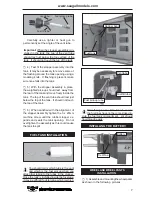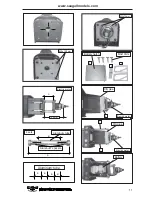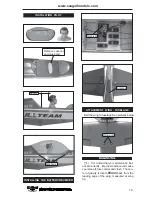
CAP 232.
Instruction Manual
20
5) If your radio transmitter is equipped
with dual rate switches double check that they
are on the low rate setting for your first few
flights.
65mm.
Do not use the aerobatic settings for
initial test flying or sport flying.
1) We highly recommend setting up the
CAP 232
using the control throws listed at
right. We have listed control throws for both
Low Rate (initial test flying/sport flying) and
High Rate (aerobatic flying).
3) When the elevator, rudder and aileron
control surfaces are centered, use a ruler and
check the amount of the control throw in each
surface.
The control throws should be
measured at the widest point of each sur-
face!
2) Turn on the radio system, and with the
trim tabs on the transmitter in neutral, center
the control surfaces by making adjustments
to the clevises or adjustable servo connectors.
The servo arms should be centered also.
CONTROL THROWS.
F) From behind the airplane, look at the
aileron on the right wing half. Move the aileron
stick to the right. The right aileron should move
up and the other aileron should move down. If
it does not, flip the servo reversing switch on
your transmitter to change the direction.
2) Check every bolt and every glue joint
in the
CAP 232
to ensure that everything is
tight and well bonded.
PREFLIGHT CHECK.
1) Completely charge your transmitter
and receiver batteries before your first day of
flying.
3) Double check the balance of the air-
plane. Do this with the fuel tank empty.
4) Check the control surfaces. All should
move in the correct direction and not bind in
any way.
2) If the nose of the plane falls, the plane
is nose heavy. To correct this first move the
battery pack further back in the fuselage. If
this is not possible or does not correct it, stick
small amounts of lead weight on the fuselage
sides under the horizontal stabilizer. If the tail
of the plane falls, the plane is tail heavy.
To correct this, move the battery and receiver
forward orif this is not possible, stick weight
onto the firewall.When balanced correctly, the
airplane should sit level or slightly nose down
when you lift it up with your fingers.
E) Check the throttle. Moving the throttle
stick forward should open the carburetor bar-
rel. If it does not, flip the servo reversing switch
on your transmitter to change the direction.
D) Check the rudder. Looking from be-
hind the airplane, move the rudder stick to the
right. The rudder should move to the right. If it
does not, flip the servo reversing switch on
your transmitter to change the direction.
FLIGHT PREPARATION.
A) Check the operation and direction of
the elevator, rudder, ailerons and throttle.
C) Check the elevator first. Pull back on
the elevator stick. The elevator halves should
move up. If it they do not, flip the servo re-
versing switch on your transmitter to change
the direction.
B) Plug in your radio system per the
manufacturer's instructions and turn every-
thing on.
4) By moving the position of the adjust-
able control horn out from the control surface,
you will decrease the amount of throw of that
control surface. Moving the adjustable con-
trol horn toward the control surface will in-
crease the amount of throw.


































